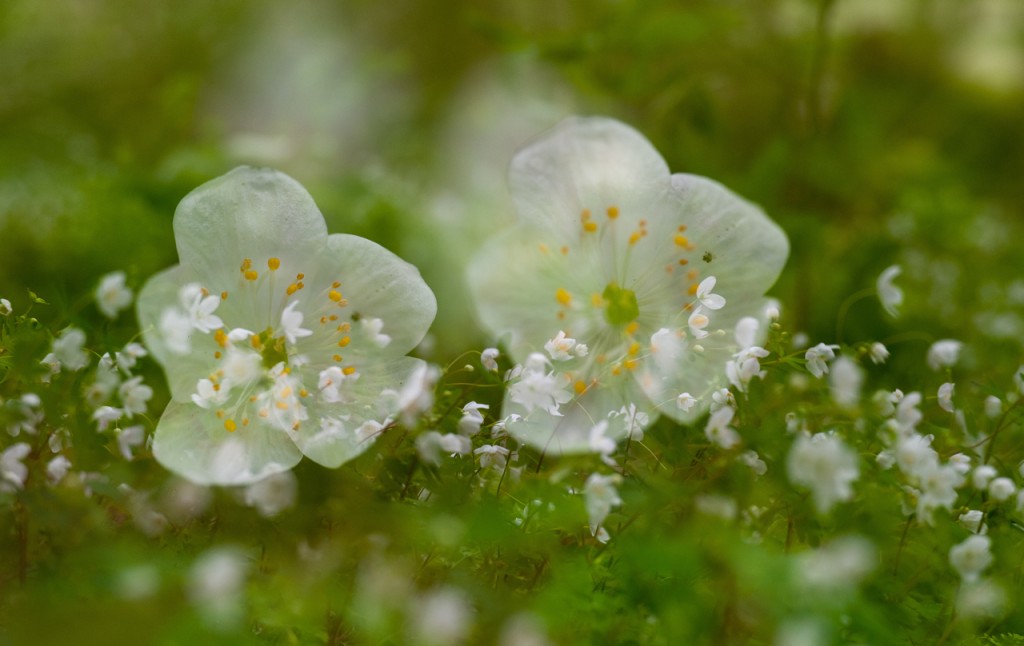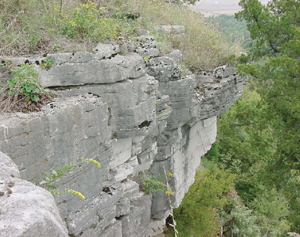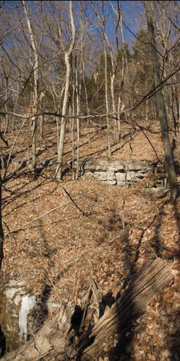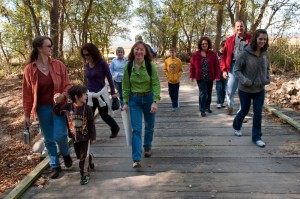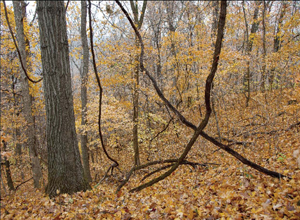White Rock
Driving directions to the White Rock parking area and a trail map of the nature preserve can be found by clicking on the link, below; White Rock Nature Preserve has a reference address of 6438 Bluff Road, Valmeyer, IL.
The landforms stand largely unchanged. The viewscape is immense and sweeping. Rock ledges and outcroppings — perched within a geologic timeframe that dwarfs the human referent of time – define their own dimension of change, influenced only by wind and weathering.
The grassy prairie bluff edges – natural vantage points – allowed long views up, down and across the miles-wide river valley. From the valley floor, the palisades of rock stretched like a shining necklace against the deep shade of the immense forest that rode across ridges and uplands until meeting the tallgrass prairies miles and miles away to the east.
White Rock will be protected forevermore. Its natural heritage is held in trust so that generations to follow ours may enjoy and take inspiration from the site, from its wildlife, and from nature.
Clifftop and the Southwestern Illinois Resource Conservation and Development (SWIRC&D, now HeartLands Conservancy) purchased the White Rock lands in December 2010. The two local nonprofit non-governmental organizations partnered for the project, each bringing unique skill sets to a conservation tool kit. Several “first-ever-in-Illinois” innovations followed. Clifftop and the SWIRC&D crafted a joint venture agreement – the first such agreement in Illinois – to seek funding for the purchase, jointly own, hold and steward the tract.
The organizations received approval for partial funding of the project through the State Wildlife Grant, a U.S. Fish & Wildlife Service program administered through the Illinois Department of Natural Resources (IDNR). This is the first SWG funding for land acquisition made to a nongovernmental joint partnership in our state. And, recognizing both the tract’s value as a natural area and the innovative nonprofit partnership the two land trusts had created, the Illinois Clean Energy Community Foundation and Grand Victoria Foundation’s Vital Lands Illinois program awarded generous grants allowing completion of the acquisition and development of public access infrastructure for the 306-acre section.
“Land conservation is central to our quality of life,” said Nancy Fishman, Executive Director of Grand Victoria Foundation. “This is especially true in southwestern Illinois, where natural preservation is not just a matter of protecting our natural legacy, but promoting our economic prosperity. Visitors drawn to the region’s endearing landscape spend significant dollars annually in St. Clair, Monroe and Randolph Counties. Acquisitions like White Rock help protect the places we love against rapid land development, provide spaces for recreation and reflection, and preserve our natural heritage.”
“Protecting such a spectacular parcel called for innovation. These two groups—Clifftop and the Southwestern Illinois Resource Conservation and Development, Inc.—really rose to the occasion on this project. The Foundation is pleased to support their partnership and the purchase of such an important natural area,” said Jolie Krasinski, Program Officer at the Illinois Clean Energy Community Foundation, which makes grants to acquire natural areas throughout the state.
The White Rock conservation project resulted from strong and innovative partnerships. It is a testimony to the creative power of collaboration between citizens, locally-led conservation groups, government agencies, and private foundations all focused on protecting and preserving our natural heritage for future generations.
“This is a milestone in our continuing efforts to preserve the bluff lands that make Monroe County one of Illinois’ most beautiful,” said George Obernagel, President of the Clifftop Board of Directors. “The White Rock Nature Preserve project is for the people of Monroe County—saving some beautiful and natural area space as a public place.”
The 306-acre White Rock Nature Preserve opened as a public place in October 2011. Hiking, bird and wildlife watching, photography, and the simple rewards of strolling through woods or, as is possible from the vantage point of our hill prairie overlooks, the unique experience of looking down at soaring eagles and vultures all are part of the pleasures of White Rock.
White Rock Nature Preserve offers a narrative of our history in these lands, too, and a reminder of how precious our natural heritage is.
Native Americans gathered and hunted for foodstuffs, altering the landscape to aide their labors by setting fires to maintain the open woodlands and fringes of grass along the hill prairies to enhance the lands for the wildlife they depended upon.
Euro-Americans initially confined their settlements to the rich lands of the river bottoms, timbering forested acreages and transforming grasslands into farm fields. Later settlers moved to the forests, clearing uplands for new fields to meet an ever-expanding market for crops. Tallgrass prairie became intensively farmed fields; the great forest, too, was largely transformed, remaining only in isolated pockets too steep for farming and in large swathes up and down the steep ravines of the western uplands.
During the Great Depression, hardlaboring men hewed limestone from the hillside and loaded it onto mule-drawn wagons for the haul down the narrow trail, across the creek bed that would foam with torrents of water following a rainstorm. That rock, used on roadways and fields, forged new connections between growing towns and increasing populations. The miners called this place White Rock.
By then, the lands of White Rock and all the once-wildlife-rich grasslands and forests were no longer home to many species of wildlife than had lived here. Buffalo, elk, cougar, black bear, wolf, passenger pigeon, Carolina parakeet, and other wildlife forms all were extirpated during the 19th century. Whitetail deer and wild turkey also became extinct in the area, brought back through intensive restoration efforts during the last half century.
The landforms remain. An enchanting natural beauty – towering trees, rain-induced waterfalls, autumn-orange bunch grass, springtime dogwood flowers dancing on the breeze – endures and endears. Abundant wildlife still make this place home: spring mornings are filled with birdsong, snakes still follow scent trails along generational pathways to and from winter hibernacula, deer, raccoons and opossums seek sustenance among the acorns and hickory nuts that litter the forest floor.
The property is a designated Illinois Natural Area Inventory Site for its ecological quality and importance. White Rock contains a mosaic of hill prairies and limestone glades, a large swathe of upland forest and is home to several threatened or endangered species. Looming above the Mississippi River floodplain, this richly forested landscape is part of one of the most unique, intact and healthy ecosystems in our state.
White Rock is both a gift from the past and a promise to the future made possible by conservation and land protection efforts.
Please click below for additional information about White Rock Nature Preserve:
- Driving directions to and trail map for White Rock Nature Preserve
- White Rock Nature Preserve Opens!
- Photo album of White Rock Nature Preserve

